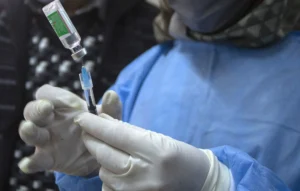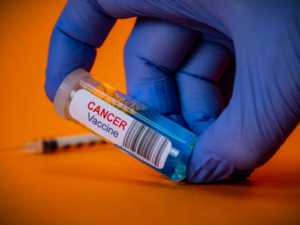In recent years, scientific advancements in cancer research have been accelerating at a remarkable pace. Among the most promising developments is the discovery of a cancer vaccine that can stop tumor growth before it spreads to other parts of the body. This breakthrough offers a new hope in the battle against cancer, which remains one of the leading causes of death worldwide. In this blog post, we will dive deep into how the cancer vaccine works, the process behind its development, and its potential impact on cancer treatment.
What Is the Cancer Vaccine That Stops Tumor Growth?
A team of researchers has successfully developed a cancer vaccine designed to halt the growth of tumors in their early stages. Unlike conventional vaccines that are used to prevent infections, cancer vaccines aim to enhance the body’s immune system to recognize and fight cancerous cells.
This new vaccine is particularly effective in stopping tumors from spreading (metastasizing) to other organs and tissues. When a tumor metastasizes, it becomes much more difficult to treat, often leading to poor outcomes for patients. The vaccine’s ability to prevent this metastasis is a groundbreaking development in the field of cancer treatment.
Understanding the Science Behind the Vaccine
To comprehend how this cancer vaccine works, it’s important to understand the concept of the immune system’s role in fighting cancer.
- Immune System and Cancer Cells: The immune system is designed to identify and destroy harmful invaders, such as viruses, bacteria, and abnormal cells, including cancer cells. However, cancer cells can sometimes evade detection by the immune system, allowing tumors to grow unchecked.
- Tumor Microenvironment and Metastasis: Cancer cells can enter the bloodstream or lymphatic system, which allows them to travel to other parts of the body and form new tumors. This process is known as metastasis and is responsible for the majority of cancer-related deaths. Stopping metastasis is crucial in improving patient outcomes.
- How the Vaccine Triggers the Immune System: The cancer vaccine works by introducing a unique set of cancer-specific proteins or antigens into the body. These antigens are found on the surface of cancer cells and are not typically present on healthy cells. The vaccine stimulates the immune system to recognize these antigens as foreign and trigger an immune response.
- Stopping Tumor Growth: Once the immune system is trained to recognize cancer cells, it attacks and destroys these cells before they have a chance to multiply and spread. In the early stages, before cancer cells can metastasize, the immune system eliminates them entirely, halting tumor growth at the source.
How Does the Cancer Vaccine Work in Practice?
The process of creating and administering the cancer vaccine follows a series of carefully controlled steps:
- Step 1: Identifying Cancer Antigens Researchers first identify specific proteins or antigens that are present on the surface of cancer cells. These antigens are unique to cancer cells and are not found on normal cells. These antigens serve as the target for the vaccine.
- Step 2: Vaccine Development The identified cancer antigens are then synthesized and prepared to be introduced into the body. This can be done in several ways:
- Peptide-Based Vaccines: Small fragments of the antigen are used to stimulate the immune response.
- DNA or mRNA Vaccines: These vaccines use genetic material to instruct cells in the body to produce the cancer antigens, triggering an immune response.
- Dendritic Cell Vaccines: This approach involves collecting immune cells, priming them with cancer antigens, and then reintroducing them into the patient to stimulate a targeted immune response.
- Step 3: Administration of the Vaccine The vaccine is administered through an injection, similar to traditional vaccines. The immune system recognizes the cancer-specific antigens as foreign and begins producing antibodies and immune cells to target and destroy the cancer cells.
- Step 4: Monitoring the Immune Response After vaccination, the patient is closely monitored to ensure that the immune system is responding appropriately. Blood tests, imaging, and biopsies may be used to track the progress of the immune response and check for any side effects.
- Step 5: Prevention of Metastasis In clinical trials, patients who received the vaccine showed a significant reduction in the ability of their tumors to metastasize. By stimulating the immune system early in the process, the vaccine prevented cancer cells from spreading to other organs.
Potential Impact of the Cancer Vaccine on Cancer Treatment
The discovery of a cancer vaccine that halts tumor growth before metastasis offers significant promise in cancer treatment. Here’s how it could impact the future of cancer therapy:
- Preventing Metastasis: One of the greatest challenges in cancer treatment is dealing with metastasis. Once cancer spreads to other parts of the body, it becomes far more difficult to treat effectively. By preventing metastasis, this vaccine could help keep cancer localized, making it easier to manage and treat.
- Enhanced Effectiveness of Existing Treatments: This vaccine could be used in combination with other cancer treatments, such as chemotherapy, radiation therapy, and immunotherapy. By stopping tumor growth and preventing the spread of cancer cells, the vaccine could enhance the effectiveness of these treatments and reduce the need for invasive procedures.
- Improved Survival Rates: The ultimate goal of any cancer treatment is to improve survival rates. If this vaccine proves to be effective in human clinical trials, it could play a critical role in reducing cancer-related deaths by preventing tumors from spreading to other organs.
- Cost-Effective Treatment: In the long term, a vaccine that prevents metastasis could reduce the need for expensive treatments for advanced cancer. By catching the disease early and preventing its spread, the healthcare system could save billions of dollars in treatment costs.
- A New Era of Cancer Prevention: If this vaccine becomes widely available, it could be a game-changer in cancer prevention. In the future, individuals with a high risk of developing certain types of cancer could receive the vaccine as a preventative measure, significantly reducing their chances of developing the disease.
Challenges and Future of Cancer Vaccines
While this new cancer vaccine is a breakthrough, several challenges remain:
- Vaccine Specificity: Different types of cancers have different antigens, and not all cancers respond to the same treatment. Researchers must develop tailored vaccines for various types of cancer to ensure effectiveness across a wide range of patients.
- Clinical Trials and Long-Term Results: More clinical trials are needed to verify the safety and long-term efficacy of the vaccine. It is crucial to monitor patients over extended periods to ensure that the vaccine does not produce adverse effects and remains effective over time.
- Cost and Accessibility: The cost of developing and distributing cancer vaccines is a significant consideration. Researchers must ensure that the vaccine is affordable and accessible to all patients, regardless of their economic background or location.
- Combination with Other Treatments: Researchers will also need to explore how this vaccine can be integrated with existing cancer treatments. Combining the vaccine with other therapies could yield better results, but careful studies are required to determine the most effective treatment combinations.
Conclusion
The discovery of a cancer vaccine that can stop tumor growth before it spreads marks a monumental advancement in cancer treatment. By harnessing the body’s immune system to recognize and destroy cancer cells, this vaccine has the potential to prevent metastasis, significantly improve survival rates, and enhance the effectiveness of existing treatments.
While the research is still in its early stages and more trials are needed, this breakthrough offers a glimmer of hope for the millions of people worldwide affected by cancer. As scientific understanding of the disease continues to grow, the possibility of curing cancer may one day become a reality. The future of cancer treatment is promising, and the development of vaccines like this one is a step closer to making cancer a disease of the past.
As we await further advancements, one thing is clear: the fight against cancer has entered a new phase, and innovations like these offer hope for a healthier, cancer-free future.



